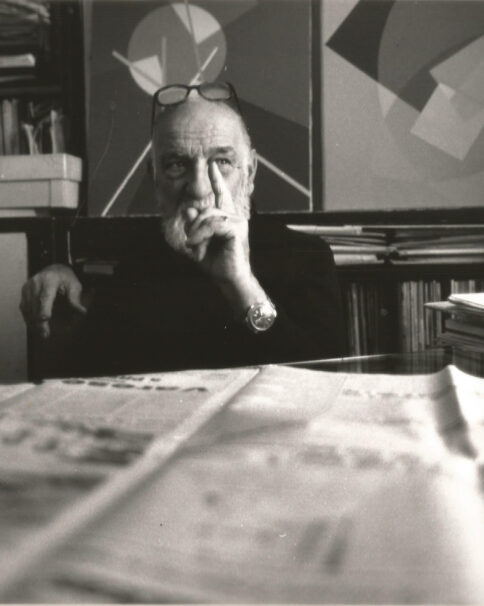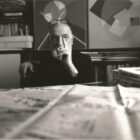LUIGI VERONESI (May 28, 1908 – February 25, 1998, Milan) was a photographer, painter, scenographer and experimental film director, one of the main protagonists of Italian abstract art.
In the 1920s, he pursued technical and scientific studies (textile design, photography, mathematics, physics), frequented the Italian intellectuals associated with the magazine Poligono and the artists linked to the Il Milione gallery who sought to renew national art in the spirit of the European avant-gardes. At the age of 20, he became interested in painting and took classes with the Neapolitan painter Carmelo Violante, then a professor at the Carrara Academy in Bergamo. Among his first influences were obviously the Futurist painters, although he did not identify at all with their commitment to the defense of fascism or their nationalist ideas (during the Second World War, he was part of the Italian Resistance).
At the end of the 1920s, inspired by his father, Veronesi experimented a lot with photography, also without a camera. In 1929, shortly after Christian Schad (1919), Man Ray (1922) and Laszlo Moholy-Nagy (1922), he discovered for himself the technique of the photogram that he would perfect and develop in the years to come by freeing himself from the constraints of objectivity. Some of his creations would be reproduced on the covers of the magazines Campo Grafico and Ferrania.
In 1930, during the 17th Venice Biennale, he discovered the works of Wassily Kandinsky, Paul Klee and Oskar Schlemmer which revealed to him a new approach to art. He then began to study the publications of the Bauhaus which confirmed him in his path towards abstraction and led him to take an interest in the work of the Russian constructivists. During this period, he invested a lot in the theatre, creating sets that did not contain any figurative elements and minimalist costumes, reduced to a few strong lines relating to the actors’ bodies as if they were architecture. His first experiments with photomontage and graphic design also date from the early 1930s. In 1933, he joined the Milanese magazine Campo Grafico, which aimed to revolutionise current typographic models in the spirit of the teachings of Adolf Loos, De Stijl, L’Esprit Nouveau and the Bauhaus.
In 1932, the Libreria del Milione presented Veronesi’s first solo exhibition, which brought together woodcuts, still figurative. The same year, he travelled to Paris, where he met Férnand Léger, Georges Vantongerloo, Robert and Sonia Delaunay, who helped him clarify his artistic thinking. By joining the Abstraction Création group two years later, he became an important intermediary between Milanese and Parisian artists: in issue 4 of the Abstraction Création notebooks, alongside Veronesi’s abstract woodcut SR3, part of his joint exhibition with Josef Albers at the Galleria del Milione (1934), there are also works by Lucio Fontana, Fausto Melotti, Mauro Reggiani, Virginio Ghiringhelli. In 1935, they all took part in the “First Collective Exhibition of Italian Abstract Art” (organised in the studio of the painters Felice Casorati and Enrico Paolucci in Turin) and signed its manifesto. That year, during a visit to the Müller collection in Basel, Veronesi viewed the works of Alexander Rodchenko and El Lissitzky; he also met Laszlo Moholy-Nagy, with whom he would subsequently maintain a long and rich correspondence. The Hungarian’s work also encouraged him to combine oil painting and photograms by adding geometric constructions on canvases treated with photosensitive substances and exposed to light. He also began to produce abstract photographs and photomontages, and even to juxtapose the two.
Since the end of the 1930s, Veronesi has been very active in the fields of theatre, cinema and music. Between 1938 and 1980, he made nine experimental and abstract films, painting directly on the film (unfortunately, only short excerpts of these films survived the war). As in the case of other international avant-garde artists, Wassily Kandinsky or Frantisek Kupka, the Italian’s abstract research is directly linked to music. Following Kandinsky’s thinking that music, thanks to its mathematical and scientific foundations, constitutes a model for the other arts, he studied the mathematical relationships between musical notes and sought to translate them into tonal relationships of colors, making numerous chromatic transpositions of musical scores. In 1939, at the Galerie L’Équipe in Paris, he showed 14 variazioni di un tema pittorico (1936) which inspired the composer Riccardo Malipiero to write 14 variazionimusicali, played during the exhibition by the pianist Nadja Tagrin

